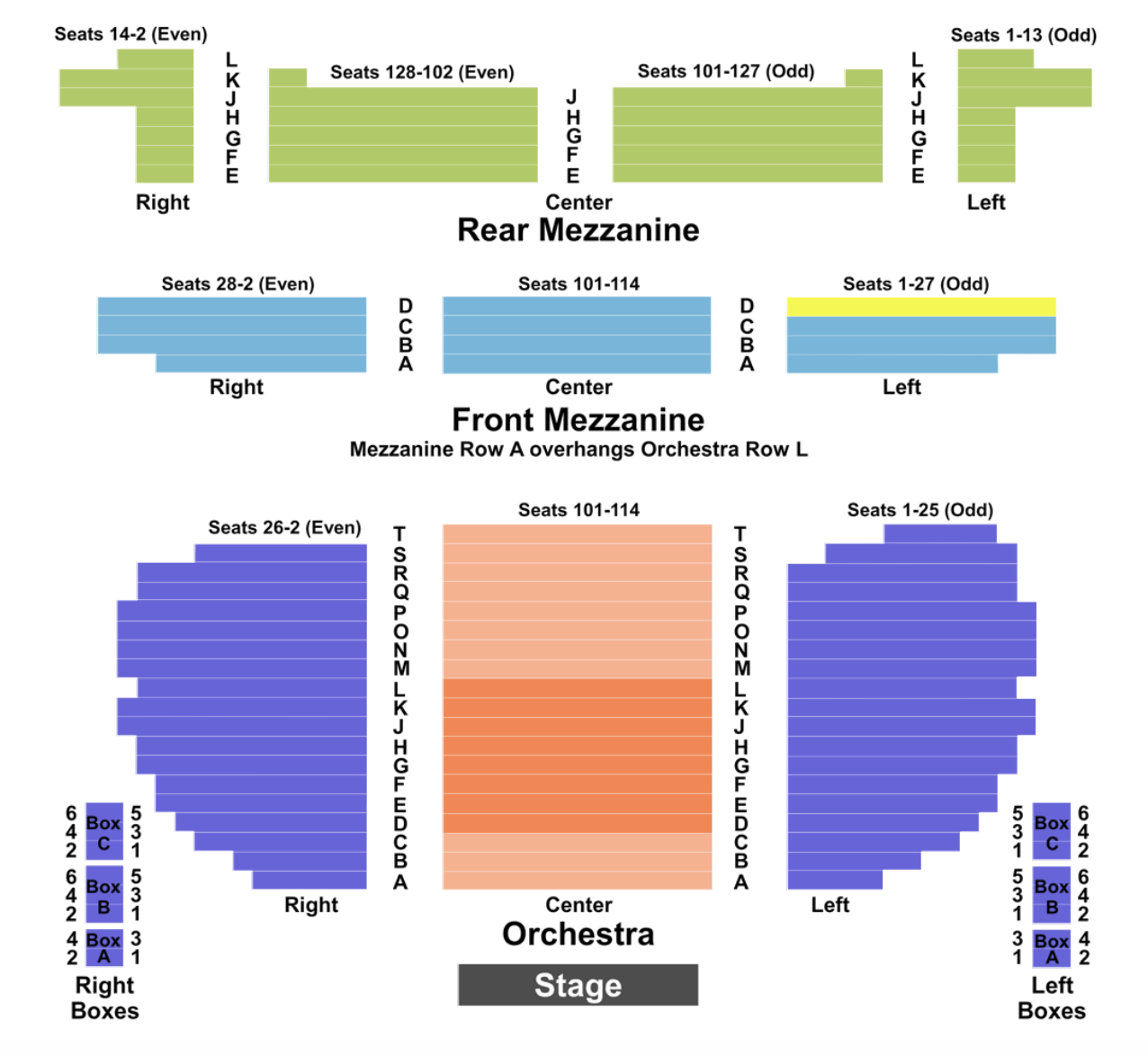Eugene O'Neill Seating Chart + Section, Row & Seat Number Info
August 15, 2019
Thank you for visiting TicketIQ’s Eugene O’Neill Theatre seating chart blog post. Our goal is to provide the most updated Eugene O’Neill seating chart, with details on row and seat numbers, and how to find discounted or last-minute tickets.The Eugene O’Neill Theatre is a Broadway theater located at 230 West 49th Street in New York City. It seats 1,102.
🎟 VISIT TICKETIQ FOR LOW PRICE GUARANTEES ON EUGENE O'NEILL THEATRE TICKETS 🎟
Eugene O’Neill Theatre Seating Sections
Orchestra: There are three Orchestra Sections: Right, Center and Left.
Front Mezzanine: There are three Front Mezzanine Sections: Right, Center and Left.
Back Mezzanine: There are four Back Mezzanine Sections: Right, Right Center, Left Center and Left.
Boxes: There are two Box Sections, Right Box and Left Box, each with three sections – A, B and C.
Eugene O’Neill Theatre Row Numbers
Orchestra rows start with ‘A’ closest to the stage and ‘T’ is the last row in the Orchestra. In the Front Mezzanine, rows are lettered A-D, and in the Back Mezzanine, rows are lettered E-L on Right and Left, and E-K in the Center sections. Each Box has two seats per row.
Eugene O’Neill Theatre Seat Numbers
Orchestra: Seats are divided by even and odd, with even-numbered seats 2-26 in the Right Orchestra, odd-numbered seats 1-25 in the Left Orchestra, and seats 101-114 in the Center Orchestra.
Front Mezzanine: Seats are divided between even and odd, with even-numbered seats 2-28 in the Right Front Mezzanine, odd-numbered seats 1-27 in the Left Front Mezzanine, and seats 101-114 in the Center Front Mezzanine.
Rear Mezzanine: Seats are divided between even and odd, with even-numbered seats 2-14 in the Right Rear Mezzanine and102-128 in the Center Rear Mezzanine. Odd-numbered seats 1-13 are in the Left Rear Mezzanine and 101-127 are in the Left Center Mezzanine.
Eugene O’Neill Theatre Seating Chart

Eugene O’Neill Theatre Handicap ADA SEATING
Wheelchair and companion seating is available in the Orchestra Sections. There are no steps leading into the theater or the Orchestra section. There are 25 steps between the Orchestra and Mezzanine sections and two steps between Mezzanine rows. There is no elevator or escalator in the theater.
Other assistive devices available at the St. James Theatre
Patrons with hearing loss can get information about options at www.tdf.org, and an open-captioned performance of The Book of Mormon is scheduled for September 25, 2019 at 7 p.m. The theater also offers multiple options for vision- or hearing-impaired patrons, including D-Scriptive devices for the blind and I-Caption devices for the deaf.
What’s playing at the St. James Theatre?
The Book of Mormon is a parody of Mormon beliefs and practices that ultimately shows the power of service and love. The show is a musical comedy tracing two Mormon missionaries who try to preach to a remote African village. The missionaries are generally ignored as villagers are focused on more pressing issues from AIDs to famine to oppression from local warlords, but in the end, the villagers do buy into some of the missionaries' teachings and unite with the missionaries against the local warlords to make the town their own form of paradise.
🎟 VISIT TICKETIQ FOR LOW PRICE GUARANTEES ON THE BOOK OF MORMON TICKETS 🎟
The Book of Mormon won nine Tony Awards, including including Best Musical, and a Grammy for Best Musical Theater Album. It is the brainchild of South Park creators Trey Parker and Matt Stone, who partnered with Avenue Q’s Robert Lopez.
The show got rave reviews when it opened, including this gem from the Huffington Post in previews: “Is it as subversive as South Park? Unequivocally, The Book of Mormon is pee-in-pants funny, outrageous, shocking, which you’d expect. What you might not have seen coming are energetic and elaborate dancing, catchy tunes, insight into the nature of faith and the American hubris of spreading our brand of magic and lies all over the globe.”
How long is The Book of Mormon and are there any age restrictions?
The Book of Mormon runs approximately 2 hours, 30 minutes and has one intermission. The show is recommended for ages 12 and up, and children four and under are not permitted in the theater.
What facilities are available at the Eugene O’Neill Theatre?
Restrooms are located one level down from the lobby, and an accessible rest room is available at the adjacent Time Hotel. There is no formal coat check available, but theater staff will check oversized bags at a cost of $3 per item. Drinks and snacks are available at bars on each level.
How to get lower-priced, last-minute tickets at the St. James Theatre
Standing-Room Only: Standing-room tickets are available for $27 one hour prior to curtain for sold out shows. Patrons can buy these tickets on the day of the show at the theater box office.
General Rush: None.
Digital Lottery: Entries are accepted to the digital lottery as early as one week before the desired show until 11 a.m. the day before the performance. The drawing is held at noon the day before the performance, and tickets cost $50, payable by credit card. Winners are notified by e-mail and must purchase tickets by 4 p.m. the day before the performance. It is likely tickets will be obstructed or partial view, and pairs may be split up.
Face-value cancellation tickets may also be available through the cancellation line on the day of the show.
Discounted Tickets: For theatergoers with flexibility, TKTS Discount Booths are a great way to see theater in New York City at affordable prices. Known for their iconic booth located around Manhattan, they offer discounts of 20% to 50% off face value tickets, and have limited availability of unsold tickets for purchase on the day of the event. TKTS Discount Booths in New York City, including the flagship location in the heart of Times Square, with booths at South Street Seaport and Lincoln Center. One extra benefit to using TKTS is that your ticket purchase does toward supporting the Theatre Development organization, which is dedicated to sustaining and sharing the arts and building audiences of the future.

